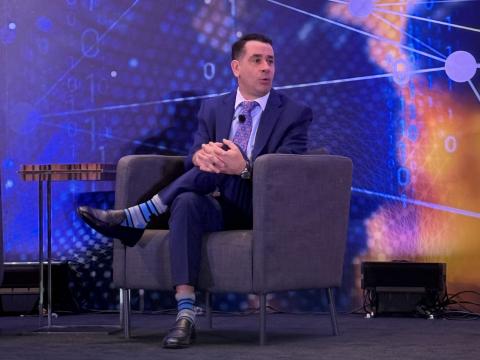Tactical Communications Solutions Offer Promise
Software-defined networks, commercial satellite communications, cognitive electronic warfare, intelligent radios and artificial intelligence applications all potentially offer the military advanced capabilities for the tactical environment, say Johns Hopkins University Applied Physics Laboratory’s (APL’s) Julia Andrusenko, chief engineer, Tactical Wireless Systems Group, and Mark Simkins, program manager, Resilient Tactical Communications Networks.
As a 20-year research engineer at APL in communications focusing on radio frequency (RF) propagation and prediction, and electromagnetics, Andrusenko works on the physical system side, examining tactical networks, antennas and radios, and associated applications of artificial intelligence and machine learning. And as the chief engineer in the Tactical Wireless Systems Group, Andrusenko is responsible for the technical quality of their projects on behalf of their U.S. military clients.
For certain Defense Department sponsors, Andrusenko is examining the possibilities of software-defined networking, harnessing architecture that uses digital and cloud-based networking configurations to optimize network performance. The flexibility and scalability of software-defined networking makes it attractive for tactical applications, the chief engineer says.
“Software-defined networking is the whole notion of creating these sorts of separate pipelines based on the need,” she explains. “For instance, some of my applications might not require a lot of bandwidth, whereas others require live streaming of video. And having that flexibility at the core network is what seems really appealing to our Defense Department sponsors.”
Andrusenko also is reviewing cognitive electronic warfare (EW) solutions and the connection to cognitive radio networks. With such cognitive systems, the EW device or radio can intelligently make a decision when and where to transmit or act in the spectrum. The systems, naturally, require adroit spectrum situational awareness.
“I’ve just finished a draft manuscript for a cognitive EW book,” she offered. “We are looking at any cognitive system, and there is a huge overlap with cognitive radio networks as they all need spectrum situational awareness,” she said. “I’ve been looking to see what machine learning methods can be applicable to these cognitive systems, especially if the computational abilities are limited.”
On a larger scale, a network of intelligent radios and how they work together becomes an even greater challenge to tackle, the chief engineer adds.
“That becomes a multi-agent problem,” Andrusenko states. “And then we run into the issue of cooperation, coordination and communication, and how do you amalgamate the radios. This could be the same thing for wireless sensor networks. It depends on the mission or on the function of your system, and what you are trying to achieve. Cognitive networks may just observe, or learn the spectrum and then transmit, or sense, or perform whatever cognitive EW is needed—either defensive or offensive EW—but these all obviously have different objectives. The main thing is how do you train your systems or your radios a priori. How do you train them to recognize various signals present in the field and then make some type of decision depending on the mission?”
The Defense Department also is concerned with how to harness data at the tactical edge, but this too “is a really complex problem,” Andrusenko ventures. “With our military sponsors right now there’s just so much data and a hunger for accessing data, and accessing it quickly, with the lowest latency as possible,” she explains. “If you have access to multiple data sources and they’re not homogeneous then data fusion becomes a consideration. And to understand your environment, you have to know how the information propagates through your system.”
Artificial intelligence (AI) and machine learning will be the linchpin to cognitive systems, Andrusenko continues. “Coming from an AI perspective, you can probably apply AI and machine learning to every aspect of intelligent system design,” she notes. “And this would help the warfighter by taking off the mental load from having to process all the information that is coming in from all kinds of different sources and make a decision.”
In addition, the APL is investigating how the Defense Department can leverage commercial low-earth-orbit satellite communications (LEO SATCOMs) for tactical military applications. “[We] are looking now at using commercial LEO broadband SATCOM systems, potentially not just for primary communications and primary links but also potentially as backhaul solutions,” she states.
Although it is not directly for tactical applications at the warfighting edge, the use of domestic 5G communications is also of great interest. “The Defense Department has 12 5G test beds that have been announced,” Andrusenko shares. “Again, it’s a commercial technology so it may not meet all of the military’s needs especially at the tactical edge, but we’re helping our various Defense Department sponsors by formulating some of the use cases for the test beds. For one of the projects I am involved with, we are trying to develop use cases for 5G with a focus on spectrum sharing, since spectrum crunch is still the real problem.”
Leveraging commercial solutions for classified—known as CSfC and published by the National Security Agency and the Committee on National Security Systems—is one possible way to use 5G networks outside of the continental United States, or O-CONUS, the chief engineer offers.
“O-CONUS use of 5G and use of 5G at the tactical edge all depends on the mission objectives,” she emphasizes. “If you are in an urban environment and there’s an existing infrastructure, there are probably ways for people to utilize existing infrastructure with commercial devices that will work and potentially loading some applications that will provide the necessary level of security. This all comes from the use of commercial solutions for classified. I’m seeing now some of the companies that produce tactical communications gear and how they are trying to see if that is going to work at the tactical edge.”
She notes that the Department of Homeland Security is looking into using CSfC with 5G in remote environments, “so potentially that could be a solution using commercial tactical communications with CSfC to provide the level of security.”
In his role as program manager at the APL, Simkins is responsible for a certain set of sponsors from the U.S. military, making sure that APL meets their technical research needs in the areas of resilient radio frequency communication, networking and defensive network security. He works with both the Army and Air Force program executive offices in tactical networks, cross-functional teams and the services’ research organizations, such as the Army’s Combat Capabilities Development Command C⁵ISR Center and the Air Force Research Laboratory.
“For the resilient tactical communications piece, I am part of a larger program area called comms [communications] and networking, and my piece focuses specifically on essentially battlefield comms and networks,” he explains. “I have a little expression I like to use. I call my program ‘unbreakable network and unstoppable comms,’ because that’s my goal for the sponsors.”
For warfighters to operate in an environment that is highly contested, Simkins is examining radio frequency communications with low probability of detection and low probability of intercept, including highly directional solutions and antenna technologies. “There is this urgency around how in the world can we both hide and dominate the spectrum,” he states. “We are looking at solutions that enable hiding in plain sight and clever ways of communicating that the adversary can’t detect. Other research areas include using nontraditional modulation so the adversary can’t identify what you’re doing or that it’s you. We also want to keep the adversary from using it, or even making them afraid to turn on their radio. We also want to automate a lot of these processes.”
Echoing Andrusenko’s efforts regarding bandwidth use, Simkins’ group is researching how to provide more access to the spectrum. “There’s this insatiable need for bandwidth,” Simkins notes. “You have warfighters, weapons and everybody needs a piece of that bandwidth. There are several ways to deal with that. One is just being more efficient with the spectrum that you have, so dynamic spectrum access technologies are a big focus area of ours. Another way is just freeing up more spectrum. Some of these millimeter wave or terahertz communications technologies and approaches are ways to address that problem as well.”
Conducting modeling, simulation and load analysis of the network traffic also is a research focus. “If you add up all the people who might want to use the tactical network on a given day, it’s going to far exceed the bandwidth, so you have to be smart about identifying which data is mission critical and how it gets through the systems,” he ventures.
In addition, Simkins is investigating advanced antennas for tactical use. “Even at the tip of the RF spear, the antennas, our folks have worked for decades with the Navy and are really good at antenna apertures and element-level digital arrays, and things like that. Those [solutions] are of great interest when it comes to both directional networking and defending against adversarial jammers. Even things like metamaterials where you can actually make a passive antenna or can modulate an incoming signal and then reflect it to somewhere else are advantageous.”
On the tactical network side, the APL’s research is examining automatic systems and autonomous networking, and applying “some degree” of artificial intelligence and machine learning. Such applications could detect adversarial behavior and then react, re-configuring or shutting part of the network down, Simkins notes.
“Part of our effort there is to make sure that the sponsor base has the mindset that the network is a weapons system, and it needs to be every bit as secure as a weapons system,” he emphasizes.
The cyber defense of a network, both on the RF and the baseband side, is about defense, naturally, but also about perseverance, the engineer says. “It is how we make sure we do not just defend but we know that the adversary is going to get on the network or is going to penetrate so how can we fight through that,” Simkins offers. “It is not like you can completely eliminate a threat or bypass it, but you can bend, but not break, so to speak.
“Imagine you have a network or a situation where you have sensors that are sensing something that might not even be about the network, it may be about an adjacent network or maybe some kinetic threat that has happened and that would require a certain type of traffic to be prioritized on the network,” he continues. “And the idea is that you have this network brain, it can feed that type of information into the network, for whichever domain it is sensing in, so that it can tell you what your priorities are right now, and you can federate with another network next door to get things from point A to B. There’s a lot of work that is going on in that area as well.”





Comments